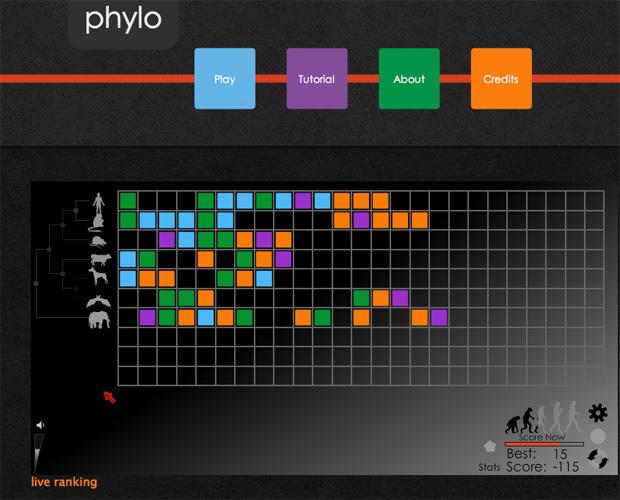Novel computer game lets players help scientists research humane genome
The online game Phylo uses rows of colored blocks to represent segments of DNA from different species. (Screen shot from the Phylo interface.)
Jerome Waldispühl and Mathieu Blanchette are sitting at their laptops in a lab at McGill University in Montreal.
The men are computer scientists, and they’re playing a game they developed.
Rows of colored blocks — orange, green, blue, and purple — appear on the screen. The goal is to match up as many blocks of the same color as possible.
Blanchette soon concedes defeat.
“Jerome wins this one,” he said.
The game is called Phylo, as in the scientific prefix phylo-, concerning related groups. The game is simple to learn, and yet it helps solve a complex problem in the study of DNA.
McGill geneticist Guillaume Bourque explains the problem by introducing his dog.
“His name is Mac,” he said, playing with his Jack Russell terrier. “Even though obviously it’s a very different animal [from us], there’s lots of things that we share.”
For instance, both humans and dogs have two eyes, a brain, four limbs, and one heart.
We also share genes. The genes aren’t exactly the same between Bourque and his terrier, but they’re pretty close.
Now, those genes make up just a small portion of our DNA. The vast majority of our DNA does not contain genes.
“It’s quite a challenge to understand how it works and what it does,” Bourque said.
Some of the DNA that sits between our genes is clearly important. For example, there are sections of DNA that control when a gene gets activated.
But identifying these DNA segments is hard. So scientists look for where our genetic code matches closely with the codes of other species. If humans and dogs, for example, share a segment of DNA, it’s probably doing something critical since evolution has preserved it over millions of years.
However, finding those patterns in DNA is something computers don’t always do very well without eating up a lot of computing time. Humans, on the other hand, can often do a better job, and more quickly. And that’s where the game Phylo comes in.
To understand, Waldispühl, the co-developer of the game, heads out onto a busy street.
“You see you have different colors,” he said, gesturing at the trees and the grass, the buses and the buildings.
Our brains quickly make sense of this complex array of colors and shapes.
“Your brain is processing all this information in some coherent way,” he explained.
This is how we navigate the world. We’re good at recognizing visual patterns. Looking out at a sea of cars, for example, it’s simple to spot three of the same color right next to each other.
“For you, it seems natural when you do it, it seems easy. It’s not because it’s easy,” Waldispühl said. “Evolution [has] trained you to acquire this capacity.”
This is what the game relies on — our natural ability to spot visual patterns.
Phylo players click on colored blocks and move them left or right to line up blocks of the same color on different rows. Each row of blocks represents a short DNA segment from a different species.
“When a computer tries to solve the problem, it will always try to solve it the same way — the way it has been programmed to solve it,” Blanchette said. “Whereas humans, because we don’t tell them how to solve it, they’ll have different strategies. That will provide us with a variety of different solutions, some of which will turn out to be better than those found by the computer.”
Therefore, asking a lot of people to solve the same problem often gives the best results, and that is what Waldispühl and Blanchette have done. They’re crowdsourcing the solution by putting the game on the web for anyone to play.
About 500 people a day are playing it from all over the world, according to the scientists.
Waldispühl credits Phylo’s success to its simple and appealing design, and to the fact that it’s not like most other computer games, where time spent is time lost.
“Potentially your game will improve the data, and these data will be useful to solve a disease and save the life of someone,” he said
Bourque — the geneticist with the Jack Russell — considers the game’s potential impact to be a bit more subtle.
“I wouldn’t expect that … there’s going to be a flash, a bulb that’s going to light up, and says, ‘Oh, by the way, you’ve solved this disease,’” he cautioned.
Still, Bourque admits the game holds promise for helping scientists solve real genetic problems.
And Waldispühl said the game offers players an unusual kind of mirror.
“It’s like humanity is having a look at itself,” he said. “A look into [its] genome.”
Even more of humanity will be able to look into its genome now that the Phylo team has translated the game into other languages. Versions in Russian, Chinese, Hebrew and several other languages have just become available on the web.
